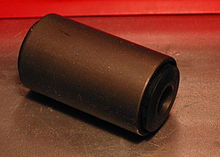

This article needs additional citations for verification. Please help improve this articlebyadding citations to reliable sources. Unsourced material may be challenged and removed.
Find sources: "Bushing" isolator – news · newspapers · books · scholar · JSTOR (February 2010) (Learn how and when to remove this message) |

Abushingorrubber bushing is a type of vibration isolator. It provides an interface between two parts, damping the energy transmitted through the bushing. A common application is in vehicle suspension systems, where a bushing made of rubber (or, more often, synthetic rubberorpolyurethane[1]) separates the faces of two metal objects while allowing a certain amount of movement. This movement allows the suspension parts to move freely, for example, when traveling over a large bump, while minimizing transmission of noise and small vibrations through to the chassis of the vehicle. A rubber bushing may also be described as a flexible mountingorantivibration mounting.
These bushings often take the form of an annular cylinder of flexible material inside a metallic casing or outer tube. They might also feature an internal crush tube which protects the bushing from being crushed by the fixings which hold it onto a threaded spigot. Many different types of bushing designs exist. An important difference compared with plain bearings is that the relative motion between the two connected parts is accommodated by strain in the rubber, rather than by shear or friction at the interface. Some rubber bushings, such as the D block for a sway bar, do allow sliding at the interface between one part and the rubber.
Charles E. Sorensen credits Walter Chrysler as being a leader in encouraging the adoption of rubber vibration-isolating mounts. In his memoir (1956), he says that, on March 10, 1932, Chrysler called at Ford headquarters to show off a new Plymouth model.
Lee Iacocca credits Chrysler's chief of engineering during that era, Frederick Zeder, with leading the effort.[3] Iacocca said that Zeder "was the first man to figure out how to get the vibrations out of cars. His solution? He mounted their engines on a rubber base."[3]
A bushing is a type of bearing that is used in the suspension system of a vehicle. It is typically used to connect moving parts such as control arms and sway bars to the frame of the vehicle, and also to isolate these parts from each other and from the frame. The main function of a bushing is to reduce the transmission of vibrations and shocks from the road to the rest of the vehicle, which helps to improve the overall ride comfort and reduce noise and harshness inside the vehicle.[4]